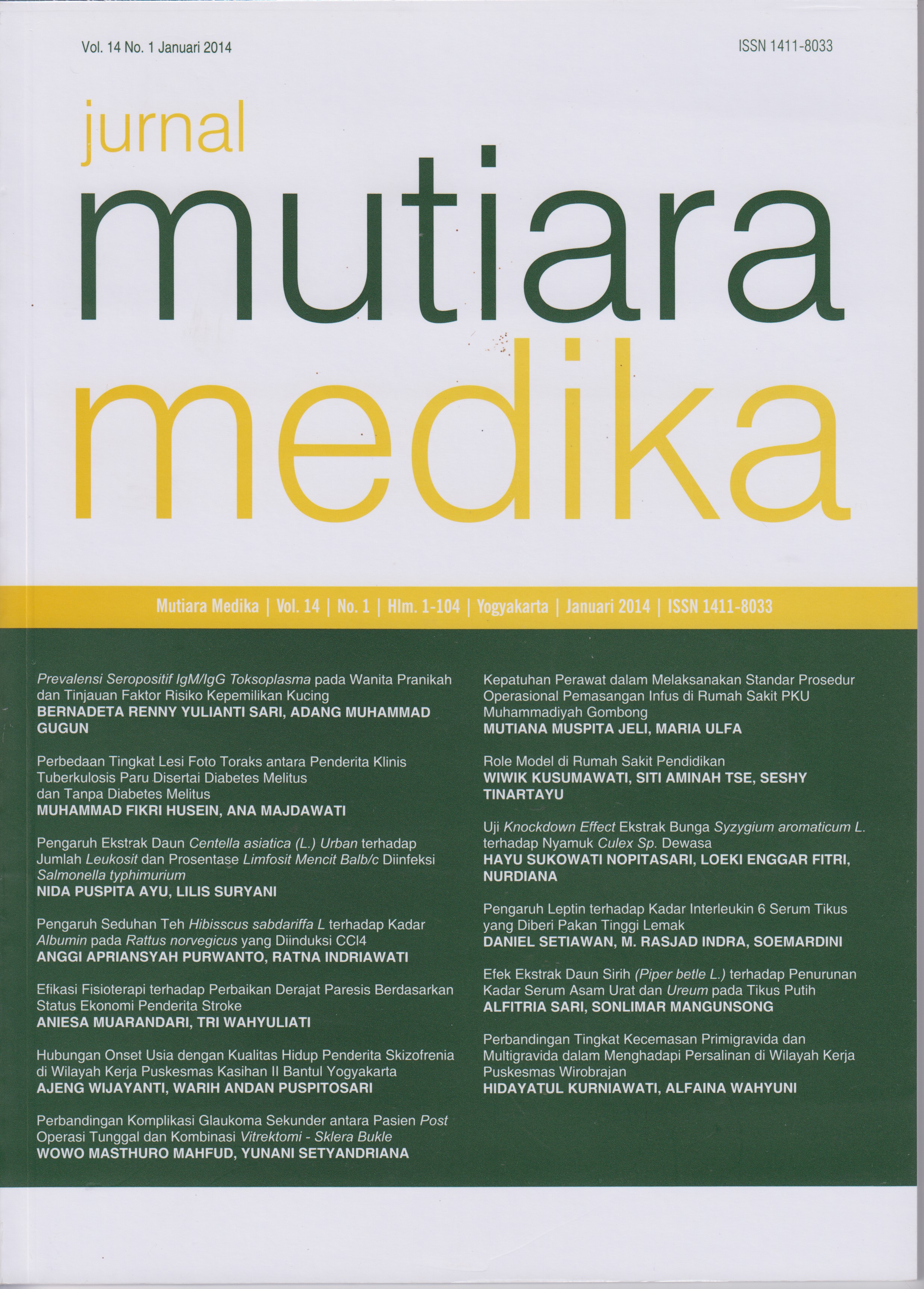Role Model di Rumah Sakit Pendidikan
DOI:
https://doi.org/10.18196/mmjkk.v14i1.2472Keywords:
role model, teaching hospital, clinical rotation, clinical teacher, rumah sakit pendidikan, pendidikan tahap profesi, dosen pembimbing klinikAbstract
Dosen pembimbing klinik pendidikan dokter tahap profesi di rumah sakit sebagai role model yang baik diperlukan untuk mengajarkan sikap perilaku, skills dan knowledge. Studi ini dilakukan untuk merumuskan konsep role model yang diharapkan oleh mahasiswa pendidikan dokter. Disain penelitian ini adalah deskriptif, cross sectional dengan pendekatan kuantitatif dan kualitatif. Metode pengumpulan data dengan kuesioner, wawancara mendalam dengan the general interview guide approach dan observasi dengan insider observer. Lokasi penelitian pada 8 rumah sakit pendidikan FKIK UMY, penentuan sampel secara purposive dengan criterion reference, yaitu mahasiswa yang menjalani stase paling lama di bagian atau mahasiswa di bagian 4 besar pada 8 RS pendidikan. Hasil penelitian menunjukkan, 70% dosen pembimbing klinik pada bagian 4 besar 8 rumah sakit pendidikan FKIK UMY merupakan role model yang baik. Berdasarkan kriteria role model dari Passi, 98% dosen pembimbing klinik menunjukkan clinical skills yang baik, 93% menunjukkan teaching skills dan personal quality yang baik. Terdapat kesesuaian terhadap role model yang diharapkan oleh mahasiswa dari hasil kuesioner, wawancara dan observasi. Rumusan role model yang baik menurut mahasiswa, yaitu mempunyai kemampuan mengajar atau teaching skills yang baik antara lain cukup waktu untuk membimbing, mampu berkomunikasi, memotivasi mahasiswa belajar, memberikan feedback, dan memiliki pengetahuan yang luas serta up date.
In clinical rotation at teaching hospital, the role of clinical teacher as a good role model was needed to teach attitude, skills and knowledge. The aim of this study is to develop concept of role model based on student’s opinions at school of medicine. This study is descriptive, cross sectional using quantitative and qualitative approach. Collecting data method conducted by distributing of questionaires, indepth interview by the general interview guide approach and direct observation by insider observer. This study conducted at 8 teaching hospitals of FKIK UMY. Sampling method by purposived and criterion referenced. The respondents was the students who conduct in longest clinical rotation i. e. 4 major departements at 8 teaching hospitals. This study revealed, 70% of clinical teacher in 4 major departements at 8 teaching hospitals is good role model. Regarding Passi’s criterias of role model, 98% of clinical teacher show good clinical skills, 93% show good teaching skills and personal quality respectively. There is similar result of concept of role model from questionaires, indepth interview and direct observation. Based on student’s opinions, a good role model should has good teaching skills such as sufficient of time to assist students, good communication skills, can motivate students, give feedback and has both wide and up date of knowledge.
References
Amin Z., Eng KH., Teaching and Learning Con¬cepts dalam Basic in Medical Education. Singapore: World Scientific Publishing. 2003.
Passi V., Doug M., Peile E., Thistlethwaite J., Johnson N. Developing Medical Professional¬ism in Future Doctors: A Systematic Review. Int. J. of Medical Education, 2010; 1: 19 - 29.
Sivalingan N. Teaching and Learning of Pro-fessionalism in Medical School. Ann Acad Med Singapore, 2004; 33: 706 - 710.
Van Luijk, S.J. Professional Behaviour: Teach-ing, Assessing and Coaching Students. Maastricht: Universitaire Pers Maastricht. 2005.
Gredler ME. Learning and Instruction Theory into Practice 6th ed. New Jersey: Pearson Edu¬cation, Inc. 2009.
Patton MQ. Qualitative Research & Evaluation Methods 3Ed. London: Sage publications, Inc. 2002.
Savitri TP. Strategi Analisis Data Kualitatif untuk Penelitian Pendidikan Kedokteran dan Profesi Kesehatan. Jurnal Pendidikan Kedokteran dan Profesi Kesehatan Indonesia, 2007; 2(1): 31 - 35.
Weissmann PF., Branch WT., Gracey CF., Haidet P., Frankel RM. Role Modeling Human¬istic Behavior: Learning Bedside Manner from the Experts. Academic Medicine, 2006; 81: 661 - 667.
Leung WC. Competency Based Medical Train-ing: Review, BMJ, 2002; 325 (7366): 693 - 696.
Egnew TR., Wilson HJ. Role Modeling the Doctor-Patient Relationship in the Clinical Cur¬riculum. Family Medicine, 2011; 43 (2): 99 - 105.
Hilton SR., Slotnick HB. Proto professionalism: how professionalisation occurs across the con¬tinuum of medical education . Medical Educa¬tion, 2005; (39): 58 - 65.
Hutchinson L. Educational Environment in ABC of Learning and Teaching in Medicine. Edited by Cantillon P., Hutchinson L., Wood D. Lon¬don: BMJ Publishing Group Ltd. 2003.
Ponnamperuma G., Ker J., Davis M. Medical Professionalism: Teaching, Learning, and As-sessment. South East Asian Journal of Medi-cal Education Inaugural Issue, 2007; 42 - 48.
Brater DC. Infusing Professionalism into a School of Medicine: Perspectives from Dean. Academic Medicine, 2007; 82(11): 1094 - 1097.
Downloads
Issue
Section
License
Copyright
Authors retain copyright and grant Mutiara Medika: Jurnal Kedokteran dan Kesehatan (MMJKK) the right of first publication with the work simultaneously licensed under an Attribution 4.0 International (CC BY 4.0) that allows others to remix, adapt and build upon the work with an acknowledgment of the work's authorship and of the initial publication in Mutiara Medika: Jurnal Kedokteran dan Kesehatan (MMJKK).
Authors are permitted to copy and redistribute the journal's published version of the work (e.g., post it to an institutional repository or publish it in a book), with an acknowledgment of its initial publication in Mutiara Medika: Jurnal Kedokteran dan Kesehatan (MMJKK).
License
Articles published in the Mutiara Medika: Jurnal Kedokteran dan Kesehatan (MMJKK) are licensed under an Attribution 4.0 International (CC BY 4.0) license. You are free to:
- Share — copy and redistribute the material in any medium or format.
- Adapt — remix, transform, and build upon the material for any purpose, even commercially.
This license is acceptable for Free Cultural Works. The licensor cannot revoke these freedoms as long as you follow the license terms. Under the following terms:
Attribution — You must give appropriate credit, provide a link to the license, and indicate if changes were made. You may do so in any reasonable manner, but not in any way that suggests the licensor endorses you or your use.
- No additional restrictions — You may not apply legal terms or technological measures that legally restrict others from doing anything the license permits.






